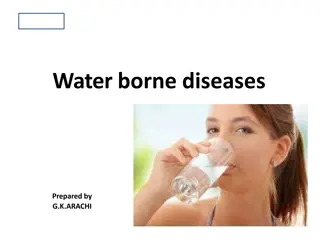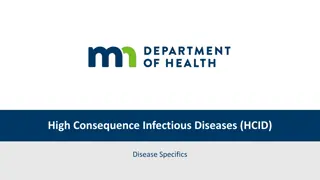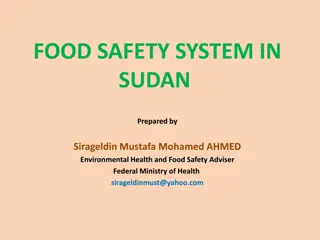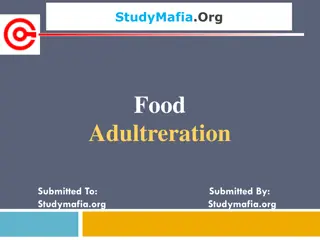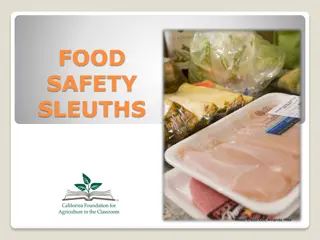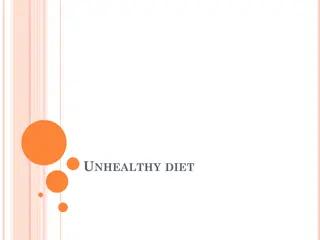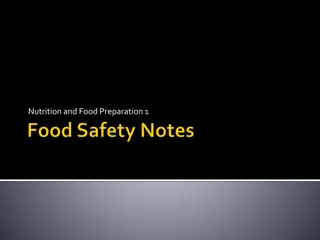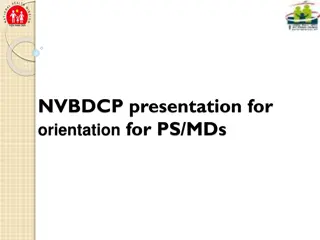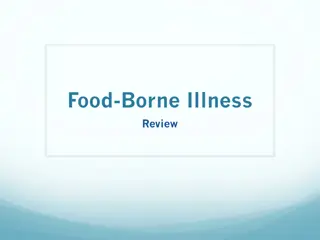Understanding Food-Borne Diseases: Causes, Symptoms, and Prevention
Food-borne diseases are caused by the ingestion of contaminated food containing microorganisms or chemicals. There are two types of food infections - contaminated food acting as a carrier of microorganisms and food serving as a culture medium for pathogens. Bacteria, viruses, and parasites are common causes, leading to illnesses such as salmonellosis, gastroenteritis, and shigellosis. Understanding the sources, symptoms, and prevention methods for diseases like salmonellosis and those caused by toxins released by organisms like Clostridium perfringens is crucial to maintain food safety and public health.
Uploaded on Sep 21, 2024 | 0 Views
Download Presentation

Please find below an Image/Link to download the presentation.
The content on the website is provided AS IS for your information and personal use only. It may not be sold, licensed, or shared on other websites without obtaining consent from the author. Download presentation by click this link. If you encounter any issues during the download, it is possible that the publisher has removed the file from their server.
E N D
Presentation Transcript
J.MYTHILI ASSISTANT PROFESSOR PG&RESEARCH DEPARTMENT OF BIOTECHNOLOGY BONSECOURS COLLEGE FOR WOMEN THANJAVUR
Food borne diseases are as a result of ingestion of food stuffs infected with microorganism or chemicals. The contamination of food may occur at any stage in the process from production to consumption.
There are two types of food infections namely. 1)contaminated food acting as carrier of microorganisms (Infections include typhoid, Cholera,dysentery , hepatitis). 2)Food that serve asculture medium for growth of pathogen( infection include salmonellosis, shigellosis, gastroenteristis).
Bacteria( Eg, Salmonellosis,Gastroenteritis, Shigellosis ) Viruses (Eg,Poliomyelitis, trichionosis, infectious hepatitis) Parasites(Eg, Ameabiasis,trichionosis,tapeworm infection)
SALMONELLOSIS: Salmonellosis is a food borne caused by the Salmonella sps. Optimum condition for growth:10-45,Ph 4-9 water activity(0.93) Incubation :12to36hrs Sources: Unrefrigerated meat and poultry Symptoms: Nausea ,Vomiting ,greenish foulstools,fever,weaknessand drowsiness Prevention:Holding food at 66C for 12 min to kill Organisms , eleminating contaminated food, cooking food for sufficient time and proper storing by cooling.
Disease caused due to Enterotoxin released in gut by Clostridium perfringens . Optimum conditions :20 to 55C, pH (5-9),heat resistant Incubation:10 to 24hrs Sources : Raw foods and food that are cooled slowely and held sometime before consumption Symptoms : Abdominal pain, diarrhoea , gas formation Prevention: Heating above 60C followed by rapid cooling of cooked meat and other foods, reheating leftovers and personal hygiene
Optimum conditions: 10-40C and pH9 (4.9-9.3) Incubation : 2 to 8hrs Sources: Contaminated foods ,cereals, mashed potatoes,vege sprouts, meat loaf, puddings Symptoms: Nausea, abdominal cramps ,vomiting ,diarrhoea. Prevention: Holding foods above 65C and reheating leftovers for 72C and personal hygiene.
Most E.coli are harmless unless they are Enteropathogenic E.coli (EEC) Incubation :8 -24 hrs. Symptoms : Vomiting ,dehydration , fever, headache,abdominal cramps, diarrhoea. Prevention: cooking food properly, rapid chilling of foods, use of protected water ,ensuring personal hygiene.
It is a bacterial dysentery caused due to Shigella sps. Sources :Moist foods like milk, potato,shrimp,tuna,turkey,apple,cider Symptoms: Fever, abdominal cramps,chills,mucus orpus, bloody stools,headache,nausea and dehydration Prevention: Personal hygine ,Control of files, Use of purified water, sanitary conditions
Common viral infections caused by Norovirus (most common viral foodborne illness,which causes gastroenteritis,a medical condition characterised by diarrhoea, vomiting and abdominal pain. Hepatitis A and E(which causes inflammation of the liver ) Rotavirus (particularly associated with gastroenteritis in children) Viruses spread through Contamination of food by infected food handlers due to poor hygienic practices. Contact of food with animal waste of ,human sewage or sewage-polluted water, Consumption of products of animal origin contaminated with viruses(eg, meat, fish ect.)
Shellfish (e.g,Oysters ,mussels),crustaceans ,and their products which are farmed and or harvested in waters near human sewage outlets (e.gwaste water treatment plants), Fruit/vegetables grown on land fertilised with animal waste or Under cooked meats such as pork. Prevention can be by Training and awareness in good hygiene practices (e.ghand washing and proper handling of fruits and vegetables ,adequate storage of food in the refrigerator, through cooking of pork meat).This is a particularly important . Where food is prepared for sick or vulnerable people in in hospitals for example. Employees suffering from illness should be restricted from food service work, Use of clean water to irrigate crops ,particularly ready to eat crops. Avoiding the use of animal manures on crops ,particularly ready to eat crops. Farming of shellfish in clean seawater protected from sewage contamination.
Infections include Amebiasis: caused by Endamoeba histolytica due to sewage contaminated in water Trichinosis : caused by Nematods due to raw ,contaminated pork Tapeworm infection : caused due to tapeworm infected pork and beef Prevention :Proper cooking ,quick freezing ,purified water and personal hygiene.
Personal hygiene Washing hands properly before and after consuming foods.






